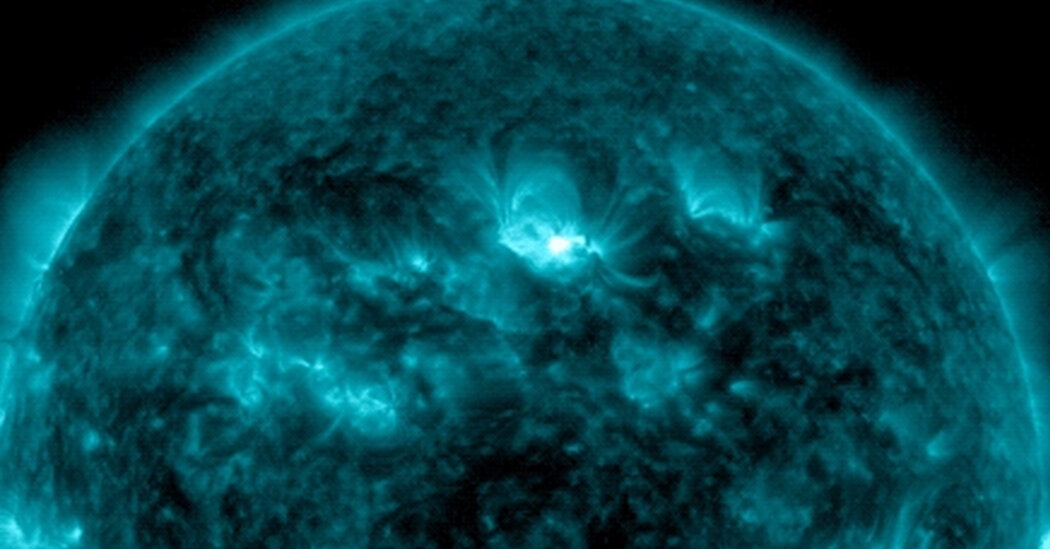Dramatic blasts of particles from the surface of the sun have prompted the National Oceanic and Atmospheric Administration to issue a severe geomagnetic storm warning.
As nuclear reactions occur on the sun, it routinely expels material from its surface. This type of space weather is what creates auroras, also known as the northern and southern lights, depending on the hemisphere in which you live. During the current geomagnetic storm, the aurora or northern lights may extend as far south as Northern California or Alabama.
But when the sun’s activity increases, the emissions it sends through the solar system can affect satellites orbiting close to Earth as well as infrastructure on the ground, leading to disruptions in navigation systems, radio communications and even the power grid.
The latest eruptions were first observed early on Wednesday morning, with at least five heading in the direction of Earth. The ejected material is anticipated to reach the planet’s atmosphere by Friday afternoon or evening. Effects could continue through the weekend.
“What we’re expecting over the next couple of days should be more significant than what we’ve seen, certainly so far,” Mike Bettwy, the operations chief at NOAA’s Space Weather Prediction Center, said at a news conference on Friday morning.
How strong is the current geomagnetic storm?
Giant explosions on the surface of the sun, known as coronal mass ejections, send streams of energetic particles into space. But the sun is large, and such outbursts may not cross our planet as it travels around the star. But when these particles create a disturbance in Earth’s magnetic field, it is known as a geomagnetic storm.
NOAA classifies these storms on a “G” scale of 1 to 5, with G1 being minor and G5 being extreme. The most extreme storms can cause widespread blackouts and damage to infrastructure on Earth. Satellites may also have trouble orienting themselves or sending or receiving information during these events.
The current storm is classified as G4, or “severe.” It is caused by a cluster of sunspots — dark, cool regions on the solar surface — that is about 16 times the diameter of Earth. The cluster is flaring and ejecting material every six to 12 hours, with the most recent activity occurring around 3 a.m. Eastern time on Friday.
“We anticipate that we’re going to get one shock after another through the weekend,” said Brent Gordon, chief of the space weather services branch at NOAA’s Space Weather Prediction Center.
How will the G4 storm affect people on Earth?
Unlike tornado watches and warnings, the target audience for NOAA’s announcements is not the public.
“For most people here on planet Earth, they won’t have to do anything,” said Rob Steenburgh, a space scientist at NOAA’s Space Weather Prediction Center.
Instead, a geomagnetic storm watch or warning indicates that space weather may affect critical infrastructure on or orbiting near Earth. It may introduce additional current into systems, which could damage pipelines, railroad tracks and power lines.
The goal of the announcements is to give agencies and companies that operate this infrastructure time to put protection measures in place to mitigate any effects.
“If everything is working like it should, the grid will be stable and they’ll be able to go about their daily lives,” Mr. Steenburgh said.
Will I be able to see an aurora?
It is possible that the northern lights may grace the skies over places that don’t usually see them this weekend. Your best bet to see them is in a place outside the bright lights of cities.
But Friday night could pose weather struggles in some places. The Northeast is likely to be blanketed in clouds.
There is a chance the skies may cooperate in the Midwest, but the hour would be closer to sunrise on Saturday. A storm system will be moving through the region, and if it swings through, there will be clear skies behind the storms. Your ability to catch a view will depend on your location and the exact timing of the storm system.
If the aurora reaches as far south as Alabama, which can happen with a G4 storm, night skies will be relatively clear in northern Alabama and Georgia. Areas in the southern Plains and Rockies might have relatively poor viewing conditions.
Farther west, the coastal states will remain relatively cloud-free, which could provide good viewing conditions. There may be high-level clouds in the mountains of Washington, but there is still a chance of clear skies.
If you are in a clear area, even well south of where the aurora is forecast to take place, snap a picture or record a video with your cellphone. The sensor on the camera is more sensitive to the wavelengths produced by the aurora and may produce an image you can’t see with the naked eye.
Another opportunity could be viewing sunspots during the daytime, if your skies are clear. As always, do not look directly at the sun without protection. But if you still have your eclipse glasses lying around from the April 8 event, you may try to use them to try to spot the cluster of sunspots causing the activity.
Why is this happening now?
The sun’s activity ebbs and flows on an 11-year cycle, and right now, it is approaching a solar maximum. Three other severe geomagnetic storms have been observed so far in the current activity cycle, which began in December 2019, but none were predicted to cause effects strong enough on Earth to warrant a watch or warning announcement.
The cluster of sunspots generating the current storm is the largest seen in this solar cycle, NOAA officials said. They added that the activity in this cycle has outperformed initial predictions.
More flares and expulsions from this cluster are expected, but because of the sun’s rotation the cluster will be oriented in a position less likely to affect Earth. In the coming weeks, the sunspots may appear again on the left side of the sun, but it is difficult for scientists to predict whether this will cause another bout of activity.
“Usually, these don’t come around packing as much of a punch as they did originally,” said Shawn Dahl, a forecaster at NOAA’s Space Weather Prediction Center. “But time will tell on that.”














